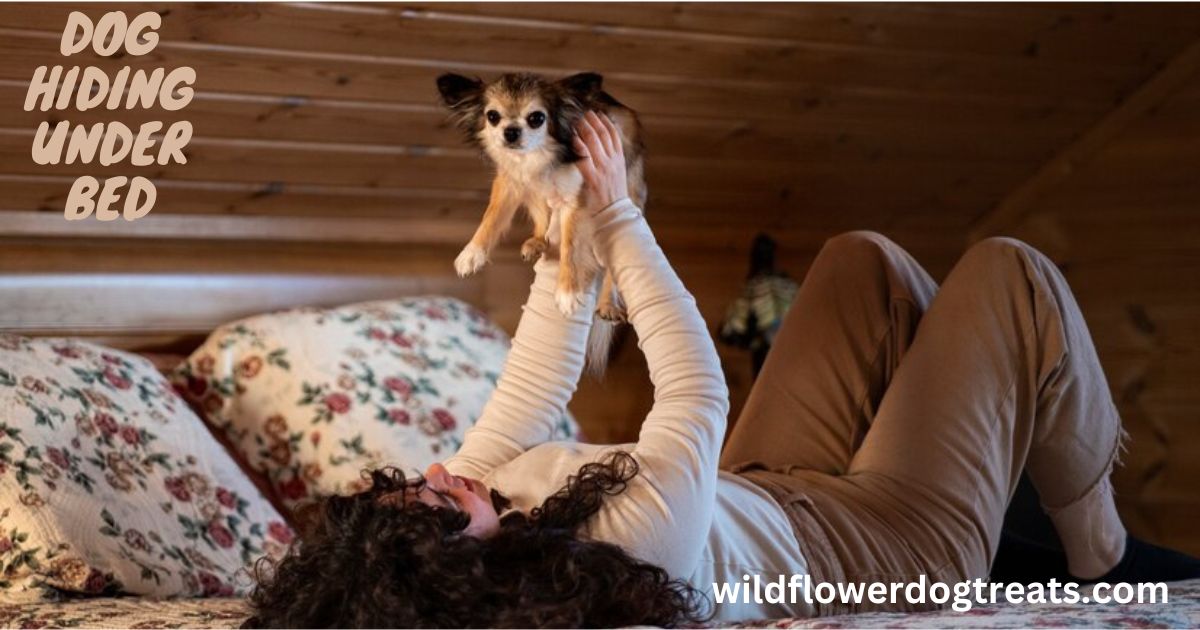If your dog is hiding under the bed, it may be due to anxiety, stress, or a need for safety. Dogs often seek seclusion to feel secure when they are anxious or scared.
When dogs hide under the bed, it can be a sign that they are experiencing fear, anxiety, or stress. This behavior may be caused by various factors such as changes in their environment, previous negative experiences, or health issues. Additionally, dogs may use the space under the bed as a secure den-like area to alleviate their worries.
Understanding the reasons behind your dog’s behavior can help you provide the necessary support and care to make them feel safe and calm. By recognizing their needs for security and addressing any underlying issues, you can help your dog overcome their anxiety and regain their confidence.
Understanding Canine Hiding Behavior
If you’ve noticed your dog hiding under the bed, it could be due to anxiety, fear, or stress. Dogs often seek safety in secluded spots when feeling overwhelmed. Understanding your dog’s behavior and providing a calm and secure environment can help alleviate their concerns.
Common Reasons For Dog Hiding
When your dog starts hiding under the bed, it can be a distressing and puzzling behavior. Understanding the reasons behind this behavior is crucial to helping your furry friend feel safe and secure.
There are several common reasons why dogs may exhibit hiding behavior:
- Illness or pain
- Anxiety or stress
- Fear of loud noises or storms
- Feeling overwhelmed by changes in their environment
- Seeking a safe and quiet space for rest
Understanding these underlying reasons can help pet owners to address the issues and provide comfort and support to their dogs.
Anxiety And Stress
Many dog owners may experience the puzzling behavior of their furry companion seeking refuge under the bed. This prevalent conduct can often be associated with feelings of anxiety and stress in canines. Understanding the signs of anxiety and stress, along with identifying possible triggers, can help provide support and comfort to our beloved pets.
Identifying Signs Of Canine Anxiety
Recognizing the signs of anxiety in dogs is essential for addressing their emotional well-being. Common indicators of canine anxiety include panting, pacing, restlessness, whimpering, trembling, yawning, excessive licking, and hiding. When a dog seeks solace under the bed, it can be a clear sign of their attempt to find a secure and comforting environment to alleviate their distress.
https://www.youtube.com/watch?v=OeCQsmp5XdI
Fear And Phobias
It can be distressing to see your beloved canine companion seeking refuge under the bed. However, it’s important to understand that this behavior may stem from fear and phobias. Dogs, like humans, can experience anxiety, stress, and phobias, leading them to seek out safe and secluded spaces such as under the bed. Addressing these underlying emotions and triggers is crucial in helping your furry friend feel more secure and comfortable in their environment.
Understanding Canine Phobias
Dogs can develop various phobias, including fear of loud noises, separation anxiety, or specific objects or situations. These phobias can manifest as hiding under the bed as a coping mechanism to escape perceived threats or sources of distress. It’s essential to recognize the signs of fear and phobias in your dog and address them with patience and understanding.
Addressing Fear-inducing Stimuli
Identifying and addressing fear-inducing stimuli is paramount in helping your dog overcome their phobias. Whether it’s thunderstorms, unfamiliar visitors, or certain noises, providing a safe and comforting environment for your dog can help alleviate their anxiety. Gradual exposure to the source of fear, paired with positive reinforcement and calming techniques, can assist in building your dog’s confidence and reducing their inclination to hide under the bed.
Health Concerns
It’s essential to be aware of the potential health concerns when your dog is hiding under the bed. Dogs may seek refuge in secluded areas when they are unwell or in discomfort. By being attentive to the signs of illness and creating a comforting environment, you can ensure your furry companion’s well-being.
Identifying Signs Of Illness In Dogs
Recognizing the signs of illness in your dog is crucial for prompt intervention. If your dog is hiding under the bed, it could be indicative of underlying problems. Look for the following symptoms that might suggest health issues:
- Lethargy or unusual fatigue
- Loss of appetite
- Trouble breathing
- Vomiting or diarrhea
- Limping or reluctance to move
Creating A Comforting Environment
Ensuring your home provides comfort and security for your dog is essential. Here are some tips to create a soothing environment:
- Soft bedding and cozy blankets can offer a sense of security.
- Dim lighting in the area where your dog retreats can help to reduce anxiety.
- Gentle soothing music or white noise can aid in creating a calm atmosphere.
- Establishing a routine for feeding, exercise, and playtime can reduce stress.
Behavioral Solutions
When your dog is hiding under the bed, it might be displaying behavioral signs that require specific attention and care. Understanding the reasons behind this behavior is the first step in finding a solution. By implementing the right techniques and seeking professional assistance when needed, you can help your furry friend overcome their anxieties and feel more comfortable in their environment.
Positive Reinforcement Techniques
Positive reinforcement is a powerful tool for modifying your dog’s behavior. By rewarding desirable behavior with treats, praise, or play, you can encourage your dog to feel more secure and confident. When your dog seeks out their hidden spot under the bed, gently redirect their attention with a toy or a treat, and praise them when they respond positively. Over time, they will associate positive experiences with coming out from under the bed, ultimately reducing their urge to hide in that space.
Seeking Professional Assistance
If your dog’s hiding behavior persists or seems to be related to anxiety or stress, it may be beneficial to seek professional assistance from a certified dog behaviorist or trainer. They can provide you with a tailored plan to address your dog’s specific needs and help you implement strategies to modify their behavior. Professional guidance can be especially valuable when dealing with underlying fears or traumatic experiences that are contributing to your dog’s desire to seek shelter under the bed.
Frequently Asked Questions For Why Is My Dog Hiding Under Bed
Why Is My Dog All Of A Sudden Hiding Under The Bed?
Your dog may be hiding under the bed due to anxiety, stress, pain, or a perceived threat. Dogs seek safety when they feel scared or anxious. Try to identify the source of their fear and provide reassurance.
Why Is My Dog Acting Strange And Hiding?
Your dog may be acting strange and hiding due to anxiety, stress, pain, or a perceived threat. Determine the source of their fear and provide a safe, comfortable environment. Sudden changes, illness, or prior negative experiences can also cause them to act differently.
Do Dogs Hide When They Are Sick?
Dogs may hide when they are sick due to feeling anxious or stressed, in pain, or trying to escape a perceived threat. This behavior is a natural instinct to seek safety when they don’t feel well.
Why Is My Dog Acting Weird And Scared All Of A Sudden?
It’s common for dogs to act weird or scared suddenly due to anxiety, stress, pain, or perceived threats.
Conclusion
If you’ve noticed your dog hiding under the bed, it could be a sign of anxiety or stress. It’s important to identify the root cause and provide a comforting environment for your furry friend. Whether it’s fear, pain, or a need for seclusion, understanding your dog’s behavior is crucial for their well-being.
Take the time to address their concerns and provide support to ensure they feel safe and secure in their surroundings.




